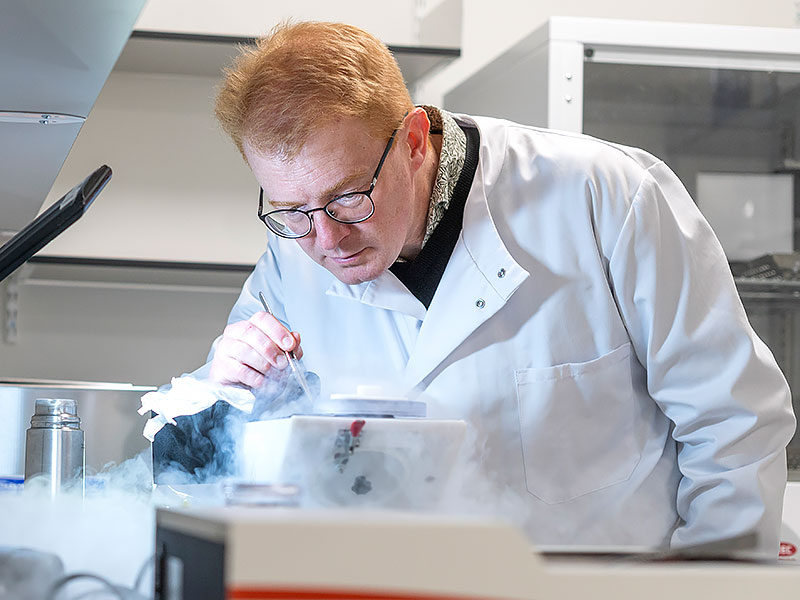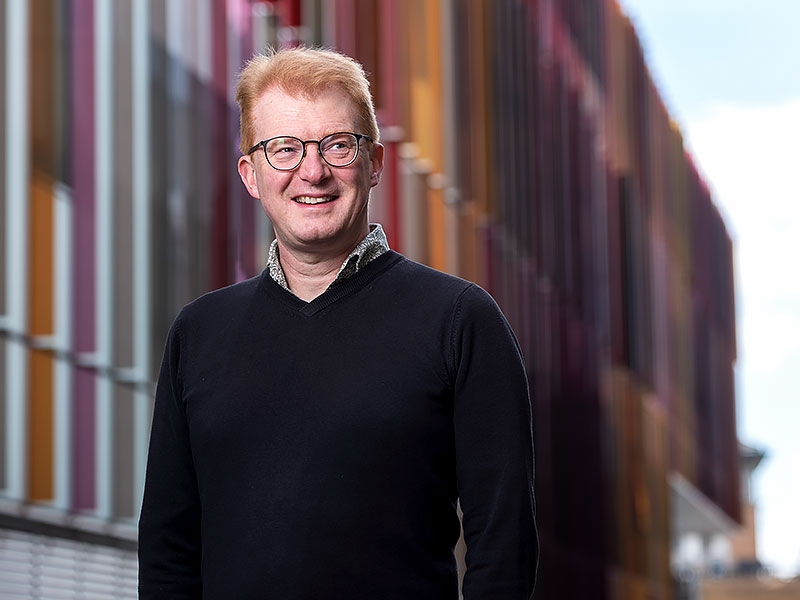Revealing the tricks that parasites use to disarm us
A structural biologist fascinated by the methods parasites use to manipulate and evade the human immune system has his sights firmly set on stopping the spread of malaria.
‘The malaria parasite is a very tricky foe,’ says Professor Matt Higgins, EP Abraham Chair of Structural Biology. ‘It’s really complex. Whereas a virus, like the one that causes COVID-19, may only have ten different types of molecules, malaria parasites have thousands and thousands. They’re much more complicated organisms and they have a lot of tricks that they can use to evade the immune system.’
One of these tricks is antigenic variation. When the parasite infects a red blood cell it sends a small number of molecules to the surface of that cell – as soon as the body learns to recognise these molecules the parasite switches them, enabling it to escape immunity. This shapeshifting nature is part of the reason why the malaria parasite remains such a significant global threat. It has nearly half of the world’s population within its reach, and is estimated to cause hundreds of millions of cases and in the region of between 600,000 and 700,000 deaths a year. The vast majority of these are of children under the age of five.
As a parasitologist and structural biologist, Professor Higgins is striving to better understand – at a very detailed molecular level – how parasites interact with their human targets, and use this information to design improved therapies and vaccines. His lab investigates a range of subjects, including amoebas, helminth worms and the trypanosomes that cause African sleeping sickness. Malaria, however, is ‘the big one among human parasitic diseases’, and a significant proportion of his team is focused on overcoming the challenges it presents.
 Professor Matt Higgins working in the lab. Photo by John Cairns
Professor Matt Higgins working in the lab. Photo by John Cairns
One of Professor Higgins’ primary concerns is understanding how the parasite gets inside red blood cells. ‘That’s a great place to intervene through vaccination,’ he explains, ‘because if you can stop the malaria parasite from doing that then you block its ability to replicate and also its ability to be transmitted.’ The Higgins Lab took a step closer to this goal in 2014 when it discovered how one of the parasite’s surface molecules, RH5, binds to the red blood cell molecule basigin, an interaction that is essential for parasite invasion. Using structural biology methods the lab was able to show exactly what that interaction looks like and, just a few years later, how it can be blocked by human antibodies – information that is being used by the team to inform the design of new vaccine components.
After much work with collaborators across Oxford, the lab’s second-generation vaccine is now being produced by the Serum Institute of India ahead of human trials, which will be led by Professor Simon Draper and are scheduled to begin later this year. There are also plans for it to enter trials combined with Professor Adrian Hill’s R21/Matrix-M vaccine, which works by stopping the initial process of liver infection by the malaria parasite. The hope is that by bringing a liver-stage vaccine together with a blood-stage vaccine, it will be possible to increase efficacy even further. ‘There is an agenda to eradicate malaria, which would be wonderful,’ says Professor Higgins. ‘We’re some way from that at the moment, but a lot of people are working on different strategies and hopefully by combining them, it will be possible.’
‘Being in a university with so many different skills and ways of looking at the same problem is really powerful. If all of these ideas and approaches can be brought together, we can push forward and solve it’
Delving into the molecular mechanisms that parasites use to invade our cells is not only useful for designing vaccines. Helminth worms are some of the world’s most common parasites and can cause a wide spectrum of disease in their hosts, from mild to potentially deadly. To aid their survival the worms secrete a cocktail of molecules that suppresses their host’s immune system, but which also subdues several negative effects of immune activation. ‘People who are infected with these worms are less affected by asthma or allergies,’ explains Professor Higgins, who is working with colleagues in Dundee to understand why this is. ‘Because parasites are ancient things that have co-evolved with us, they’re very good at maintaining low-level chronic infections by supressing our immune systems – learning how they do it could help us to control our own immune systems as well.’
Huge advances in electron microscopy and AI-based protein production and design over the past decade have been crucial in enabling Professor Higgins to advance his work with parasites. He now hopes to pay this forward in his role as the EP Abraham Chair, a post that sits across the Department of Biochemistry, the Sir William Dunn School of Pathology and the Kavli Institute for Nanoscience Discovery. ‘One of the challenges in structural biology is that it uses large and expensive pieces of equipment,’ he explains, ‘and so part of my role is to help build facilities that can be used by all of the structural biologists across Oxford, and to ensure that our training programmes are top quality so that we can work at the forefront of these techniques.’
 Professor Matt Higgins outside the Dorothy Crowfoot Hodgkin Building. Photo by John Cairns
Professor Matt Higgins outside the Dorothy Crowfoot Hodgkin Building. Photo by John Cairns
The EP Abraham Chair of Structural Biology was endowed in 2022 with support from the Edward Penley Abraham Research Fund and the EPA Cephalosporin Fund. Professor Edward Penley Abraham was a biochemist who made critical contributions to the development of penicillin and later led the discovery of cephalosporin, an antibiotic capable of destroying penicillin resistant bacteria. The registration of a patent on cephalosporin generated a regular income for Professor Abraham, which he used to establish both charitable trusts in the 1970s for the support of research and education.
Professor Higgins describes the funds as having been ‘hugely powerful’ for bioscience at the University. As well as enabling the endowment of the post that he now holds, they have provided over £38 million in combined philanthropic support to Oxford since the 1980s, including for other key academic posts, scholarships, buildings and equipment. Significant research funding has also been awarded over the years. ‘Their funding is targeted in such a way that it benefits the maximum number of people,’ he explains. ‘Because my post is endowed, there will always be someone who is working to support the structural biology community at the University.’
In addition to enabling Professor Higgins to focus on this aspect of the role, he says that holding an endowed chair will also give him ‘more time to think big thoughts’ about his research. The next big challenge for him to overcome is fully understanding how malaria parasites invade red blood cells. ‘We’re seeing bits of that process now,’ he says, ‘but to be able to see the whole cellular process as it takes place, using all of these new methods, will be really exciting.’
Support the medical sciences at Oxford